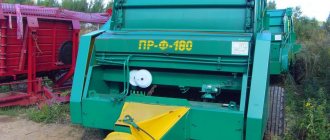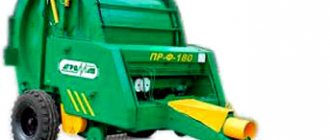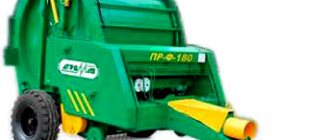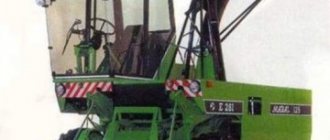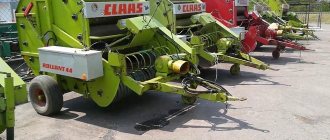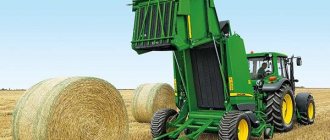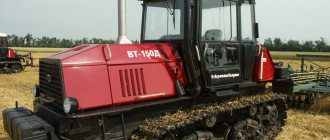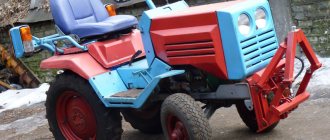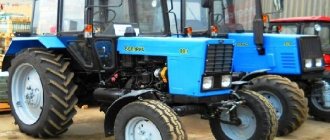The Sipma baler models Z-224/1 and 224/2 are designed for forming bales of hay and straw. The design has a special device for collecting material and subsequent compaction. The resulting briquette is stored on the ground or delivered to a trailer. To tow the device, a tractor with a traction force of at least 0.9 tons, equipped with a driven power take-off shaft with a rotation speed of 540 rpm, is used.
ABOUT
Manufacturer of agricultural and garden equipment - today is one of the leading manufacturers of agricultural equipment in Eastern Europe. This is not one enterprise, but a large Polish agricultural holding, uniting several factories in the Lublin region of the Polish Republic, with the main legal address in the city of Lublin. This city has a solid history of producing agricultural machinery: the first enterprise producing mechanical threshers and straw cutters opened here back in 1835.
Nowadays, they produce dozens of types of agricultural machinery, various household and garden tools, trailers and semi-trailers. Due to its relatively low price and proven quality over the years, these products are widely used in 31 countries around the world. First of all, naturally, in the countries of the former socialist camp and the republics of the USSR.
Baler “Sipma Z-224”: rear view
The Sipma Z-224 square baler is one of the “hit” products of the Polish company and, to some extent, its “calling card”. This model has been produced for over 25 years; The number of these agricultural machines sold in different countries exceeded one hundred thousand.
This fact certainly speaks in favor of this model. With its reliability, unpretentiousness and trouble-free operation, the Sipma Z-224 press has earned itself an almost impeccable reputation over the years.
Scope of application of the Sipma Z-224 baler, its varieties
As already noted in the introductory part, this model is intended for use in medium and small peasant farms. The baler significantly facilitates and optimizes labor costs when preparing feed for large and small livestock. He collects hay and straw cut into windrows, rolls and presses them into regular parallelepipeds up to one and a half meters long.
It is possible to use the Sipma Z-224 to harvest the fodder of legumes and the mown mass of corn and sunflower for silage in the same way. The weight of briquette bales ranges from 7 to 50 kilograms, depending on the source feed material and the density of its compaction.
The resulting bales, from seventy cm to one and a half meters long, can be dumped on the field or, when installing special skids, pushing each other, they can be fed directly into the trailer. The feed height can be adjusted up to 2.8 meters inclusive. The trailer attaches to the baler at the rear; a person stands in it and accepts the compressed material: bale by bale, stacking them in a trailer behind him, like a children's construction set from blocks.
Baler "Sipma Z-224" with skids for loading onto a trailer
The Sipma Z-224 square baler can work with any tractors with a traction class of 0.9 and a power of 38 horsepower and above. Available in two modifications: “Z-224/1” and “Z-224/2”. The difference between them is that the first has a mechanical drive for lifting the pick-up to bring it into the transport position; and the second is hydraulic.
Structure and principle of operation of the Sipma Z-224 press
High-pressure balers are designed for collecting and baling dry hay, straw, seed and natural crops after harvesting with a grain combine.
Main components and spare parts of the Sipma Z-224 baler:
- articulated telescopic shaft;
- safety friction clutch;
- flywheel clutch;
- main gearbox of the press;
- chain and pick-up drive tensioners;
- pressing chamber;
- flywheel;
- picker;
- screw feeder;
- knitting machines.
The press is supplied with 3 guide hinges, 5 M6x35-B-8.8 bolts and 5 M6-8 nuts.
Design and principle of operation of the Sipma Z-224 baler
Over the years of operation, a special, patented balanced crank-piston system has proven itself well. It minimizes and practically eliminates vibrations harmful to the operator and the tractor, and significantly increases the comfort of work. Sipma square balers are equipped with angular gearboxes, which make it possible to receive 100 press piston strokes per minute at 540 rpm of the tractor power take-off shaft.
Special cardan-telescopic shaft with a torque of 540 rpm. transmits torque from the tractor PTO to the shaft of a one-way clutch located on the flywheel of the press. The manufacturer does not recommend exceeding 600 rpm. The press flywheel is protected by a steel casing.
A one-way friction clutch protects the driveshaft from damage. It transmits the drive of the tractor to the flywheel, which accumulates energy and reduces the speed using an angular transmission.
A special piston with cutters performs reciprocating movements on rollers in the pressing chamber. While feeding the harvesting material from the lower pick-up into the bale chamber, the piston compresses a portion of the feed mass and cuts it off. The degree of compression and pressing of the material depends on the resistance that it encounters as it moves inside the bale chamber. This compression indicator (and, accordingly, the bale weight) can be adjusted with special knobs.
After compacting the harvesting material, as soon as the set bale length is reached, the tying mechanism is activated. The needles, performing pendulum movements, wrap the bale with twine and feed it into two binding devices. In them, the rope is tied, cut and pulled to the required length needed to form the next bale.
The finished bale, tied with twine in two places, is pushed out by further portions of the already compressed and ready-to-be-compressed harvesting material and lands on the ground behind the semi-trailer. Or it moves on skids to an additional trailer, immediately for loading.
Technical characteristics of the Sipma Z-224 baler
- Overall dimensions (no more), in millimeters (Length x Width x Height): 4850 x 2500 x 1550.
- Total weight of the baler, in kilograms: 1510.
- Width of the lower pick-up, in millimeters: 1780.
- Speed: in working condition - 7 km/h; in transport - 15 km/h.
- Dimensions of the resulting bale, in millimeters (Length x Width x Height): from 700 to 1500 x 460 x 400.
- Bale density: up to 180 kg per cubic meter.
- Productivity: 3500 bales per shift.
- Knitting twine: sisal - Tech 4600-6700; polypropylene - Tech 2500-3300.
- Power consumption: 28.5 kW / 38 hp
Technical and operational characteristics of Sipma Z-224
The Sipma baler has the following technical characteristics:
- Overall dimensions - 4.85x2.5x1.55 m.
- Unit weight - 1555 kg.
- Total width - 1780 mm.
- The width of the press chamber is 460 mm.
- The height of the press chamber is 400 mm.
- The inlet surface is 2300 cm².
- Productivity - 24 t/hour.
- Power consumption - more than 30 kW (41 KM).
- Drive shaft rotation is 540 rpm.
- Sisal twine - 4600 - 6700 tex.
- Polypropylene twine - 2500 - 3300 tex.
The baler is mounted on a class 0.9 tractor with a driven shaft of 540 rpm and is available in the following modifications:
- Z-224/1;
- Z-224/2.
Operating experience of Sipma Z-224 balers
Sipma balers have received high marks from peasants: they are reliable, easy to operate and maintain, they perform flawlessly for a long time and do not require repairs, they are of high quality, they are made conscientiously. The occurrence of malfunctions does not threaten big problems or downtime while waiting for the necessary spare parts. The press is well designed: components and assemblies are conveniently located for independent express repairs. Spare parts in stock are always available on the market. Many spare parts from other balers are also suitable.
Among the problems, periodic minor malfunctions in the operation of knitting machines are noted: needles bend and break (it is recommended to purchase several at once “in reserve”); the knotter settings are lost; you need to monitor the degree of tightening of the nut of the knitting main shaft, or even better, install a counter-nut. But you can use any rope; the feed mass in the pressing chamber is distributed evenly, and “Sipma Z-224” forms and knits dense bales-briquettes of a regular and identical rectangular shape that do not crumble.
In general, “Sipma Z-224” is a reliable baler that has been proven over the years, which will be easy to operate and will not bring much trouble to its owner. The load on the tractor from it is small, but the performance is very solid. It can be assembled without problems and works successfully in conjunction with most domestic tractors, from T-40 to MTZ-80 and modern models of Belarus tractors.
This agricultural machine for collecting hay, straw and other fodder has proven itself in the fields of many countries, including Russia and the CIS. An ideal option for preparing feed in small and medium-sized peasant farms. It is also effective, cost-effective for producing hay for sale. After all, many livestock owners prefer to buy and store bales rather than rolls.
Benefits of a square baler
Small adjustable dimensions and weight of the formed briquettes are convenient to use:
- transportation;
- warehousing;
- storage;
- the process of distribution to animals without the use of special equipment.
The bale unit is cost-effective to use for agricultural enterprises producing hay for sale, because owners of livestock enterprises prefer bales (for the above reasons) rather than rolls. Attention! The weight of the bales depends on the source plant material and the compaction density.
Do you want to decide which press machine to choose for your farm?
To do this, we also recommend that you familiarize yourself with the main features of bale units by clicking on this link, compare their characteristics with bales, and only then choose a baler of this type of crimping that is better suited than others for your specific tasks.
New and used Sipma Z-224 balers on the market
The assortment of agricultural equipment sellers in most regions of the former USSR includes the Sipma Z-224 baler and spare parts for it. The price for a new agricultural machine is in the range of 700-770 thousand rubles (depending on the region - delivery from Belarusian Brest also plays a significant role in determining the final price).
New baler “Sipma Z-224” in the fields of Ukraine.
The secondary market offers perhaps the largest number of advertisements for the sale of this model among all balers currently available.
A used agricultural machine "Sipma Z-224", manufactured in the late nineties - early 2000s, not just in working condition, but in really good condition (which can be preliminarily concluded even visually, from a photograph) can be purchased for 300-350 thousand rubles. Until recent years, balers of this brand were produced in red; The new ones are already green.
Reviews
The Sipma Z-224 square baler is a top product of the Polish company. This model of agricultural machinery has been purchased by more than 100,000 farmers from all over the world. Reviews from agronomists testify in favor of the baler.
Ivan Radmirovich, 37 years old, Astrakhan: The Z224 baler is an excellent mechanism. Simple design, spare parts are available and can be easily purchased. I bought it used, but in good condition. Works flawlessly. I haven’t done any repairs yet.”
“Sergey, 48 years old, Kyiv: “I purchased factory-made bale presses. I personally went to Brest. Delivered quickly, carried out the first launch. The units are working. This fall they have already tested it in the fields. I was pleased with the result."
Based on numerous reviews, one can judge such advantages of balers as:
- optimal design;
- excellent operating parameters;
- high reliability;
- accident-free;
- does not require repairs for a long time after the first start-up;
- high-quality assembly;
- spare parts for the pick-up are available on the market;
- ease of operation;
- low load on the tractor;
- high productivity;
- reduction of physical labor;
- high profitability and economic efficiency in the production of hay by farmers for sale.

